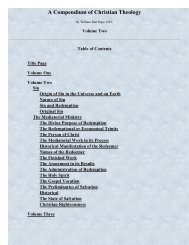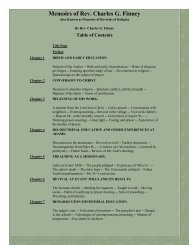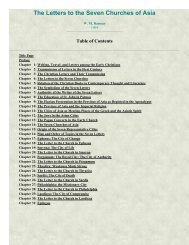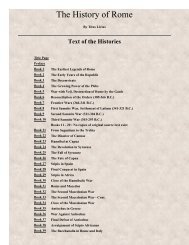Types in Hebrews - Table of Contents - Holy Pig Splash Page
Types in Hebrews - Table of Contents - Holy Pig Splash Page
Types in Hebrews - Table of Contents - Holy Pig Splash Page
You also want an ePaper? Increase the reach of your titles
YUMPU automatically turns print PDFs into web optimized ePapers that Google loves.
<strong>Types</strong> <strong>in</strong> <strong>Hebrews</strong><br />
Sir Robert Anderson<br />
CHAPTER 8<br />
WHY THE TABERNACLE?<br />
THE <strong>in</strong>terest<strong>in</strong>g question has been <strong>of</strong>ten raised, Why is it <strong>of</strong> the wilderness Tabernacle, and not <strong>of</strong><br />
the Jerusalem Temple, that the Epistle to the <strong>Hebrews</strong> speaks? The historical narrative <strong>of</strong> K<strong>in</strong>g David's<br />
reign clearly suggests that the Tabernacle represented the div<strong>in</strong>e purpose, and that the Temple was a<br />
concession to David's desire and prayer. (2 Samuel 7; 1 Chronicles 17) For God never refuses a "burnt<strong>of</strong>fer<strong>in</strong>g"<br />
from the humble and true-hearted. But as God did accept that <strong>of</strong>fer<strong>in</strong>g, the question rema<strong>in</strong>s,<br />
why the Temple has no place <strong>in</strong> <strong>Hebrews</strong>. And perhaps one reason may be <strong>in</strong> order thus to exclude the<br />
element <strong>of</strong> merely superstitious awe which a splendid shr<strong>in</strong>e is fitted to excite. The div<strong>in</strong>e presence alone<br />
can constitute "a place <strong>of</strong> worship" <strong>in</strong> the deeper, truer sense; and the exhortation to "draw near" raises<br />
the question, what and where is "the holy place" which we are bidden to approach? And to this allimportant<br />
question the n<strong>in</strong>th chapter supplies the answer.<br />
The veil which was rent when the Saviour died was not the curta<strong>in</strong> through which "the priests went<br />
always <strong>in</strong>to the first tabernacle," but the <strong>in</strong>ner veil which no one but the high priest might pass, and that<br />
only on the Day <strong>of</strong> Atonement. That veil bore testimony to the presence <strong>of</strong> God, and also to the s<strong>in</strong>ner's<br />
unfitness to approach Him. And the rend<strong>in</strong>g <strong>of</strong> it had also a tw<strong>of</strong>old significance. It <strong>in</strong>dicated the<br />
fulfillment <strong>of</strong> the solemn words with which the Lord had turned away from the holy city, "Behold your<br />
house is left unto you desolate"; and it symbolized that the true worshipper, be<strong>in</strong>g purged from his s<strong>in</strong> by<br />
the sacrifice <strong>of</strong> Calvary, might enter the div<strong>in</strong>e presence. But though the way is open, who will dare to<br />
approach? <strong>Hebrews</strong> 10:22, which we have been consider<strong>in</strong>g, deals only with the worshipper viewed as<br />
here on earth, and far more is needed if we are to draw nigh to God.<br />
From the Epistle to the Romans we learn how a s<strong>in</strong>ner can stand before a righteous God, but the<br />
Epistle to the <strong>Hebrews</strong> teaches the far deeper and more amaz<strong>in</strong>g truth that he may approach a God <strong>of</strong><br />
<strong>in</strong>f<strong>in</strong>ite hol<strong>in</strong>ess. Nor is this all, for the exhortation reads, "Hav<strong>in</strong>g boldness to enter <strong>in</strong>to the holy<br />
place…let us draw near." How can this be possible? In these days we are accustomed to hear that the<br />
solemnities <strong>of</strong> the Jewish cult belonged to the ignorant childhood <strong>of</strong> the human race, and that this<br />
enlightened age has a worthier estimate <strong>of</strong> the dignity <strong>of</strong> man. But such thoughts as these, <strong>in</strong>stead <strong>of</strong><br />
betoken<strong>in</strong>g greater moral enlightenment, give pro<strong>of</strong> <strong>of</strong> spiritual darkness and death. Those who by faith<br />
have learned the mean<strong>in</strong>g <strong>of</strong> the Cross <strong>of</strong> Christ can form a far higher estimate <strong>of</strong> the hol<strong>in</strong>ess <strong>of</strong> God<br />
than could the sa<strong>in</strong>tliest <strong>of</strong> sa<strong>in</strong>ts <strong>in</strong> a bygone age. In that age His people had to do with a mount that<br />
might be touched and that burned with fire, and with blackness and darkness and tempest, and the awful<br />
voice which filled their hearts with terror (Chap. 12:18, 19); whereas we <strong>in</strong> these "last days" are come to<br />
eternal realities more awful still, <strong>of</strong> which those sights and sounds were merely symbols. And to us it is<br />
that the exhortation is addressed, "Let us have grace whereby we may serve God acceptably, with<br />
reverence and godly fear; for our God is a consum<strong>in</strong>g fire." The secret <strong>of</strong> our boldness is not to be found








